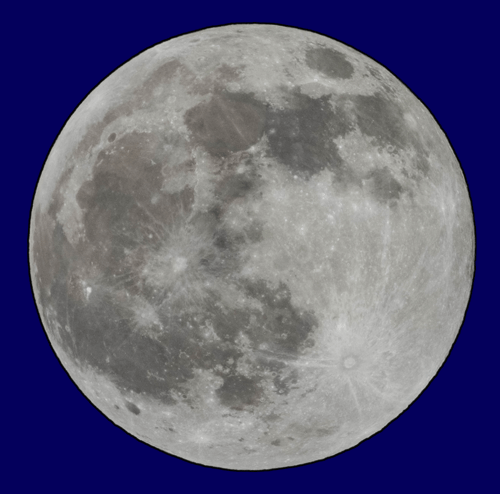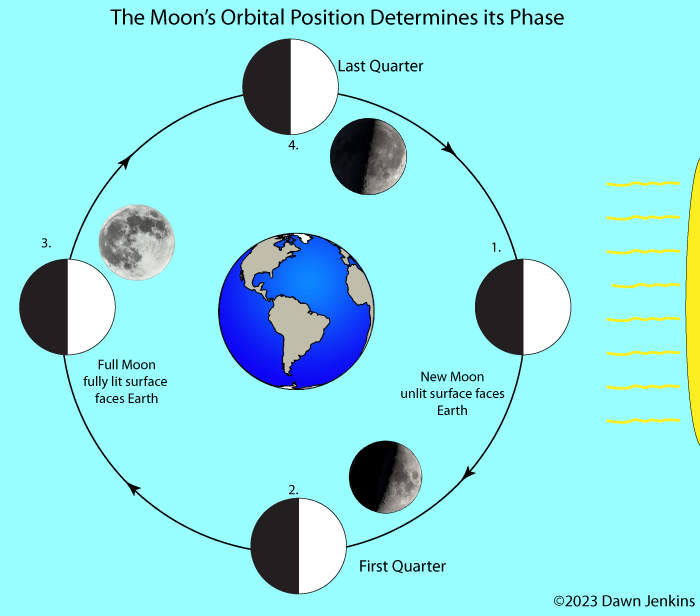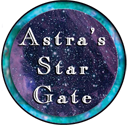You are here: Astra's Home > Space Explorers - or - Observers > Earth's Moon

The Moon is our nearest neighbor, the Earth's faithful companion. For the Earth and the Moon have been linked together since long before the first humans walked on the face of the Earth. The earliest humans must have looked up at the bright orb in wonder. Usually bright in the sky, the Moon disappears sometimes or is not seen when the observer is watching. A bit of pondering, a few days in the month - - the Moon would be present again gleaming in the sky.
Romance and wonder, the Moon may even be responsible for life that grew up on Earth. Early astronomers studied the lunar cycle until they could develop calendars based on its behavior despite the fact that the Moon moved through the stars, growing large and then shrinking again. Early star gazers learned that the Moon did have a schedule. Today, the Moon may capture the attention of those looking up in the sky. It may entice them to begin the study of astronomy, as a hobby or a profession. There is lots to see in a small telescope on the surface of the Moon.
We'd be remiss if we told you that there is a one-stop shop for lunar information, for there is truly no "All about the Moon". The truth is our solar system neighbor has been observed for so long and so much is known about it, there's just no way to include all of the known information and speculation on Earth's natural satellite. Lunar science aside, the literture and art inspired by the Moon is endless. The only name for the Moon in English is Luna and that is why this page is named Luna. The original picture here was taken by Cat Miller and posted on Unsplash. Here Astra begins the study of our nearest neighbor.
This page is under construction and is not yet active at the Gate !
On this page:
- Lunar Phases
- Lunar Features
- Tides
- Perigee and Apogee - what does it mean
- Lunar Calendars
- Lunar Exploration
Lunar Basics
| MOON PROFILE | |
|---|---|
| Diameter | 3,475 km |
| Mass: | 7.35 × 10^22 kg (0.01 Earths) |
| Primary | Earth |
| Orbital Period | 27.3 days |
| Average Orbital Distance | 384,400 km |
| Surface Temperature | T-233 to 123 °C |
Lunar Phases

Because the moon's light is only the reflected light of the Sun, this is what causes the phases of the Moon. In its orbit, about half of the Moon's surface is illuminated by the Sun. The side of the Moon that cannot be seen from the surface of Earth is sometimes called the "dark side" of the Moon, but it is more appropriately designated as the "far side" of the Moon. In order to maintain a stable orbit, the Moon must always keep one side of its disk facing the Earth.
Observations of the Moon are dependent upon its phases, these are caused by the Moon's orbit of the Earth. The Moon's orbit of the Earth is an ellipse, an elongated circle. The Moon orbits the Earth roughly around its equator. The graphic here shows this elliptical path, although it is a rough drawing and not accurate. The Moon's orbit is very close to circular, but is an elongated ellipse. When two objects orbit each other, there is actually a point that they orbit. This point is below the surface of the Earth, but not at the center.
Phases of the Moon are represented in this diagram that may seem confusing so it will be explained in detail. Many people regard the Moon from full moon to full moon, but astronomers look at the Moon beginning at the new phase. The new phase is marked on the diagram at position 1.

During new moon the Sun is illuminating the far side of the moon, so it can't be seen from Earth. The Moon will always be in the Sun. It is at this time that the Moon may come directly between the Sun and the Earth and cause a solar eclipse. These will be explained later but it is important to remember that the time of the "New Moon" is the time of the solar eclipse.
The most important phase of the moon is the first crescent. Because as the Moon orbits away from the new position, its Earth-facing surface begins to become illuminated. The Moon will appear as a tiny sliver, setting in the western sky. The Moon is still on the Sun "side" of the sky, so it won't be noticeable until the Sun sets. This is a special time because it tells astronomers that the lunar cycle is begining anew and that tiny crescent will continue to grow until the Moon is full.
This is an evening observation and has been used for millennium by humans to start a new month and regulate the lunar calender that was relied upon by many cultures and is still in use today. It is an important process because the new crescent kicks off the counting of a new month and therefore spotting the first crescent may be an important religious or secular event. The earliest sighting of a new crescent with the naked eye is held by Stephen James O’Meara who spotted the young crescent unaided by instruments 15 hours and 32 minutes after new moon in May 1990.
The lunar crescent grows as more of the illuminated surface appears while the Moon rises later and later in the day. The growth of the lunar disk is called "waxing." Waxing occurs as the until the Moon reaches a position where it is showing one quarter of its illuminated disk. That occurs on the diagram at position 2. This is called "first quarter" and is often abbreviated as "1Q." The Sun, Earth and Moon at the time of 1Q are forming a 90-degree angle. Each phase of the Moon occurs at a certain time for astronomer. It is a moment in time because the Earth and Moon are constantly moving.
After the 1Q moment, the Moon continues to wax, so that each day the disk will grow larger. As the disk of the Moon grows after 1Q, it is called "gibbous." The growing continues until the moment of Full Moon when the Moon is directly in position behind the Earth and the Sun is opposite in the sky. When the Earth is in a position that it can block the rays of the Sun from reaching the Earth, there will be a lunar eclipse. Again to be discussed later, but it is important to remember that a total lunar eclipse occurs during full moon. This is marked on the diagram at position 3.
The full Moon will rise when the Sun is set. So a large Moon in the sky means that it will be visible most of the night. Full Moon is also a moment in time, but a full Moon may be "called" for 3 days around the exact moment. Because the large moon illuminates the night time sky, there is often much more activity around the full Moon. Farmers may extend their harvest time and before human invented electric lighting, those full Moon nights were important for travelers who wished to make a long journey. They used the extra light provided by the Moon to illuminate their way after the Sun no longer shined.
After reaching position 3, the Moon will no longer grow but will begin to shrink. This is called "waning." For several days the lunar disk will grow smaller, and the time of its rising will come later in the evening. The Moon is visible in the daylight hours, appearing in the morning sky as it rises long after the Sun sets. Especially when that rising time comes after midnight. Although it wasn't mentioned before, the Moon can also be viewed in the afternoon sky when it gets far away enough from the sun after the new phase. This means that the Moon can be seen at certain times during the day and that makes for some wonderful lunar observing. The equipment can be set up during daylight hours!
The waning continues until the Moon is a small sliver rising in the early morning. You may have seen the morning crescent in the sky and noticed that you could see the entire surface, even though it was not illuminated by the Sun. You may clearly note certain features with your eye or in an instrument. This is referred to as "earthshine" because the Moon's disk is illuminated by the sun light reflection from the Earth's Surface. It is notable when the Moon is at a crescent stage, as you can see from the diagram, although the Moon is moving into the Sun, the surface of the Earth is brightly lit to an observer stationed on the Moon. The brightly lit Earth would be an amazing and impressive sight. Not only is it bigger than the moon, but it has a higher albedo. Albedo is the amount of light that is reflected by an object. The Moon's albedo is a paltry .12, reflecting 12% of the light that strikes it. While the Earth with its atmosphere reflect .37 percent of the light from the Sun. On the surface of the Moon, the brilliant Earth would actually illuminate the surface and cause soft shadows.
Blue Moon
The second full moon in a month is called a "Blue Moon". The moon doesn't turn blue but the name sticks as the second moon of the month would disrupt cycle of the seasonal names attached to full moons. (Each season usually contains three full moons, but because of the difference between the solar year and the lunar year, our faithful companion slips in an "extra" full moon periodically.)
Philip Hiscock (Folklore professor Memorial University in Canada) reported in Space & Telescope (S&T) It is a modern piece of folkelore masquerading as something old.
Where Did the Term Blue Moon Come From?
Once in a Blue Moon and Other Idioms That Don’t Make Scientific Sense
Lunar Features
The surface of the Moon is pocked with many craters.
The largest craters are called basins, the largest being South Pole, Aitken basin is 1,550 miles or 2,500 km in diameter, one of the largest impact craters in the Solar System. This basin is of great interest for lunar exploration and has been mapped by the LRO lunar probe. It is located mainly on the farside and has to be mapped by lunar probes. Some other basins are Imbrium, Serenitatis, Crisium, Smythii, on the near side. You might reconize them as "seas" or "mares", because of their large size they are visible with the naked eye. Another large basin is the Orientale basin, also predominately located on the far side of the moon. It is located on the eastern limb of the moon and its eastern rim is sometimes visible from the surface of the Earth, causing some observers to "chase" the periods that the 580 mile-wide basin (930 km) is visible.
Many lunar features were named through time by different individuals or even societies, but today's lunar feature names are managed by the International Astronomical Union (IAU). Lunar names, referred to as nomenclature. By international agreement the IAU is the single organization that controls the naming of lunar features. All astronomers, amateur and professional, world-wide, adhere to the IAU's juridiction in naming features.
Find out more about lunar nomenclature from the IAU
Perigee and Apogee
What is this perigee and apogee all about?
The Moon's orbit around the Earth not circular, it is elliptical. The amount that the Moon's orbit that does not make a complete circle is called eccentricity. The eccentricity of the Moon's orbit is 5.49%. This orbital eccentricity means that the distance to the Moon is not constant. That means the apparent size and brightness can vary. This is apsides: perigee and apogee.
It is hard to see the difference between perigee and apogee is hard to detect with the eye because there is no reference to judge its size. Away from the horizon there are no To observe the difference, you have to either make a scale to measure the Moon, or else photograph the Moon at perigee and apogee and compare the pictures, as I've done here.
Use this web page: Inconstant Moon to find out more about the Moon's apsides.
Lunar Exploration
Humans have studied our nearby neighbor for millennium. Although we learned a lot, knowledge of the Moon increased during the space age. In the 1960's and 70's, Apollo missions landed on the Moon. Since then there have been many probes launched to study the Moon in greater detail.
Now the U.S. is planning to send another crewed mission to the Moon. This mission is known as Artemis and is discussed in detail at the gate. The first mission of the Artemis program was launched in November 2022 and returned three weeks later in December. This was an uncrewed flight. The next Artemis mission will include astronaunts, flying around the Moon but not landing. The third Artemis mission will included 4 astronaunts including the first woman to land on the Moon and the first person of color. In addition to NASA's Artemis mission, many commercial space exploration missions will be launched. including Firefly's Blue Ghost and Astrobotics Commercial Missions to Luna
For detailed information on Moon missions, use the Lunar Exploration page here at Astra's.
Moon FAQ - Madison Metropolitan School District (MMSD)
